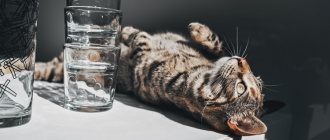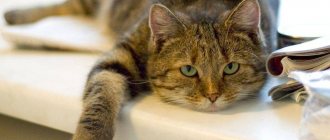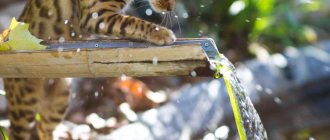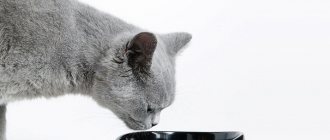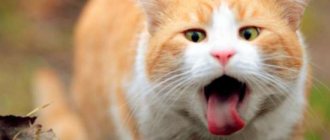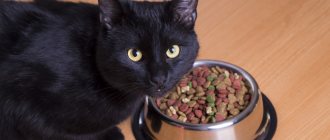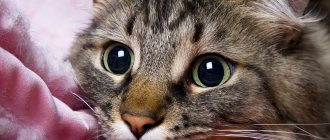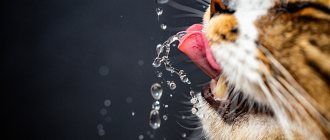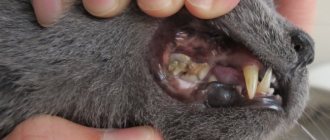Let's understand the reasons
- Fact:
Dehydration deteriorates the general condition of the kitten’s body, as well as its appearance. - Fact 2:
There is no reason to worry if the animal eats a lot of natural food containing moisture - Fact 3:
If a bowl or other container with water is in a dirty place, the cat, as a clean animal, will neglect to drink - Fact 4:
Many animals make their recovery easier by refusing food and water.
After the arrival of a little pet at home, the life of its owner is immediately filled with new worries. It is necessary to think not only about education, hygienic care, treatment and feeding of the animal, but also about its drinking regime. New cat owners are sometimes surprised to discover that their animal does not drink water at all, although it has an excellent appetite. Let's figure out why this happens and how to help the kitten.
Harm from lack of fluid in a cat's body
Concerns about possible dehydration in your pet are not unfounded. A blow to the body of a child who does not drink water can be urolithiasis. There may also be other consequences, resulting in serious pathologies leading to death. Dehydration deteriorates the general condition of the kitten’s body, as well as its appearance. Lack of water can lead to a decrease in the quality of the coat, loss or damage to the whiskers. In addition, the lack of water in the baby’s diet will lead to thickening of the lymph and improper water-salt metabolism.
Moreover, if a small animal eats dry food and does not drink water at all, this can further enhance the negative effect of dehydration. The result of such a development of the situation can be not only diseases, but also a delay in the mental and physical development of the kitten. Even if he does not want to drink, a caring owner should teach the animal not to leave a bowl of water untouched.
How dangerous is it for a cat to refuse water?
Felines by nature are light drinkers. Scientists explain this by saying that purrs descended from ancestors who lived in the desert, for whom living in arid areas and staying for long periods without fluid was the norm. In addition, pets receive a certain amount of moisture from food, provided that the owners have provided proper nutrition for the animal.
However, there is a fluid intake rate that it is advisable to adhere to:
- for adults - about 33 ml per 1 kg;
- for kittens up to one year – 70-80 ml per 1 kg.
Long-term refusal of fluids is fraught with dehydration and the development of urolithiasis, which causes a lot of problems for your pet. To prevent such a scenario from happening, you should think in advance about how to get your cat to drink. All methods will be good here, even the most creative and, at first glance, naive ones. Let's talk about them in more detail.
When is there no reason to worry?
A very small kitten has not yet transitioned to an adult lifestyle, and therefore receives all the necessary substances from the milk of its mother cat. Milk is both food and drink for the baby, so very young animals should not be persistently given water.
There is also no reason to worry if the animal eats a lot of natural food containing moisture. Such suitable foods include dairy products, eggs, buckwheat and other cereals. If your pet eats canned food, then it can also get enough water from it.
Encourage your furry's quirks
If you are faced with the task of getting a cat to drink water when dehydrated, or if your pet is suffering from urolithiasis, you can use the most unconventional methods.
For example:
- allow your cat to drink from the tap, but only if it contains clean, filtered water;
- if the cat likes to drink from a cup or glass, replace the usual bowl with a new container, etc.
It is important not to resort to extremes in trying to get your cat to drink more water - do not allow him to quench his thirst in the toilet, deep buckets or running bath. Doing so may cause poisoning or may result in falling into a container of water.
Why doesn't the kitten drink?
Experts identify several reasons why a small animal refuses water:
- The baby is very small . He only recently learned to get everything he needs from his mother. Natural instincts helped him learn to consume food, but the cat still cannot lap up water. If the mother cat lives next to him, the baby gradually learns to drink by looking at his mother. If she is in a different place, the owner will have to help the little pet by offering him a saucer of water and gently guiding him.
- If a bowl or other container with water is in a dirty place , the cat, as a clean animal, will neglect to drink. Almost all cats are not averse to drinking from a tap or bucket of clean water. To stop such actions, you need to provide your pet with a neat watering hole.
- The water container has an unpleasant odor or is very bright in color. Cats are gentle creatures, so in this case you will have to use trial and error to find the appropriate option. The solution may be to purchase a neutral-colored ceramic vessel.
- The animal may not appreciate the smell of chlorine in tap water. You should install a filter or use bottled water (usually a little is required).
- The kitten is sick. Many animals make recovery easier by refusing food and water. Sometimes the animal simply loses its appetite. At the same time, some animals continue to eat but refuse liquids. Alarming symptoms of ill health are vomiting, stool disturbances, and decreased activity of the pet. If these signs appear in parallel with refusal of water, you should contact your veterinarian.
Which water is best for a kitten?
The health of a kitten depends not only on the amount of water, but also on its quality. Before you worry about the amount of liquid you need to drink, you need to take care of which water is best for your kitten.
Types of liquid:
- Boiled;
- Distilled;
- Raw;
- Tap;
- Bottled.
Boiled water has very few nutrients. Scientists call such a liquid dead, and after three hours after boiling it becomes harmful due to the attraction of bacteria and viruses that are in the environment. Veterinarians do not advise giving your kitten boiled water not only for this reason, it can lead to the development of urolithiasis.
Distilled water is practically useless.
Tap water is endowed with many chloride compounds, various bacteria, organisms, salts and metals.
The entire composition of fresh tap water is absolutely unnecessary for a cat’s body, especially a small one.
Raw water from a spring or well is useful, but at the same time it can contain a large amount of unnecessary substances, including nitrates, iron and salts.
The best option is bottled water, but it must be of high quality. It is better to give the kitten water from a bottle, which is obtained from underground sources, of the highest category. Such water is usually not cheap and not every person buys it.
In order not to complicate your life with trips to the store and a difficult search for water of the highest category, you can give your kitten regular tap water. Before pouring it into saucers, it is worth settling or filtering the water.
How can you teach him to drink?
The easiest way to awaken your baby's thirst is to keep him busy with active games. After an active pastime, the animal loses some of the moisture in the body, so the chances of success in accustoming to a bowl of water increase.
If the animal still resolutely refuses to drink, you can use a syringe filled with water. It is advisable to place a container of water away from the bowl of food, then the water offered to the cat will remain clean and the pet will be more likely to like it.
Another way is to put water in different parts of the apartment or house. Perhaps in one of the places the animal will be more comfortable drinking - that’s where the permanent bowl is placed. It is also advisable to offer drinks from containers of different colors, sizes and shapes. As a rule, mustachioed pets prefer bowls with a large diameter.
In addition, the owner needs to understand what water temperature the kitten prefers. To do this, you can offer your baby both cold and heated liquids from the same bowl. Some kittens and adult animals love running tap water. If possible, you can leave the tap always on or turn off the water several times a day.
How can you train a cat to drink water?
To avoid health problems in the future, he must be taught to drink more from an early age. How to do this? The easiest way is to teach a cat to drink water after an active pastime. During play, the kitten loses more moisture than in a calm state. This is a great chance to teach them to drink clean, cool water from a bowl.
When a kitten categorically does not drink, you can try to force him to drink, for example, using a syringe filled with water. You can also add extra liquid to the food your cat eats if it contains little water.
There is no need to place bowls of water next to the food that the cat eats, because the liquid must only be perfectly clean, otherwise it will be impossible to accustom the pet to drinking moisture.
The selection method has proven itself quite well; to do this, you need to place bowls of clean water throughout the house, in this way you can find out exactly where the cat is most comfortable drinking moisture and what level is most convenient for him. You can try pouring it into bowls of different shapes and sizes. As a rule, pets most like bowls that resemble a lake, that is, the larger the volume, the more comfortable it is to use.
You can dilute canned food in water, this can help accustom him to water, but dry food cannot be diluted, because this can lead to improper water quality.
Another aspect is the need to understand what kind of water a cat drinks more and better. Some animals prefer cold water, some prefer room temperature, and there are cases when cats drink warm water better. When an animal prefers a flowing one, then you should think about purchasing a drinking bowl in the form of a fountain or leaving the tap slightly open. This will provide the opportunity to consume moisture at any time.
What kind of water to offer a kitten
Animals may have different water preferences, but there are some general rules:
- the water must be clean;
- various odors are not allowed, even those pleasant to humans;
- the bowl should always be accessible; you should not place it in the toilet, bathroom or other locked rooms;
- water needs to be changed regularly;
- It is recommended to first leave tap water to settle or use a filter.
Perhaps it would be convenient for the owner to teach the cat from an early age to drink regular tap water, only poured from the tap. This is not recommended, because such water contains a lot of chlorine and may contain other impurities that are not beneficial for the body.
To attract a kitten to water, some pet owners add a little of the animal's favorite treat - for example, fish. Only a small amount should be used, just to impart a slight aroma.
Drinking fountains
Automatic waterers have come into use among pet owners relatively recently, but have already gained an impeccable reputation and rave reviews.
Purrs love the sound of rushing water, perhaps it reminds them of life in the wild, or just gives them another reason to frolic with the water stream. Many models of automatic drinkers are equipped with carbon filters that remove unpleasant odors and keep the water fresh for a long time.
Manufacturers recommend changing them every 6-8 weeks depending on the level of fluid consumption and the quality of the water being poured.
How to figure out if your kitten has enough water
To understand that the animal has enough fluid for normal functioning, you need to analyze the following points:
- Condition of skin and coat . They should have a healthy appearance, without peeling or bald spots. You can pull back the kitten's scruff - with elastic skin, it will easily return to its previous position, but in a dehydrated kitten, the elasticity of the skin is lost.
- Activity . A healthy animal should be cheerful, especially in childhood.
- Frequency of urination . A healthy animal goes to the toilet 2-3 times a day. The number of approaches to the tray can be determined by how dirty it is.
How to determine lack of water?
If a cat does not drink water well, then it is important to pay attention to its general condition and appearance. The problem can be detected by the following indicators:
- Passivity and apathy. The animal stops playing games, rarely laps up water and sometimes does not want to eat. In this case, you should contact the veterinarian and find out whether the cat could have gotten sick.
- Condition of the epidermis and coat. If the water balance is disturbed, the pet looks unhealthy, the skin flakes and bald spots appear. When the owner pulls back the cat’s scruff, but the epidermis does not return to its previous position, this indicates that there is not enough water in the animal’s body.
- Daily number of urinations. If a cat drinks little water, he empties his bladder less often. A healthy individual goes to the tray at least 2 times a day.
Reasons why a kitten does not eat food
Let's figure out why the kitten doesn't eat anything? What made the baby starve?
Stress
No matter how proud cats are, they are very sensitive. It would seem, what’s wrong with moving or a change of scenery? But such little things can affect the psychological state of the animal. The animal needs a couple of days to adapt to the changed conditions. If possible, eliminate all possible sources of stress and provide your baby with peace. Let fresh water and some food be within his sight, but away from people. Perhaps the kitten needs a calm environment and privacy.
Too young
Some people buy kittens that are too small. Unscrupulous breeders are trying to “fuse” kittens as quickly as possible so that the cat goes into heat faster and gets offspring from her again. As a result, kittens do not yet know how to eat on their own. Hence the hunger strike.
The baby would be happy to eat a hearty meal, but he can’t, he doesn’t know how. To prevent the baby from starving to death, you will have to purchase a special cat's milk substitute (it costs a lot, but is ideal for kittens) and a bottle. Cow's or goat's milk are not suitable because the kitten's intestines cannot digest such fatty milk.
Environment
Cats are very clean (with rare exceptions), so they are uncomfortable with the fact that their feeding area looks untidy or dirty. The animal will endure to the last, but will not touch even its favorite food if the bowl is poorly washed or there is a lot of garbage around the feeding area.
Strong odor from food or bowl
Some bowls made of polymers, especially in the first days of their use, have a strong, unpleasant odor. Cats have a keen sense of smell. And such a “bright” chemical smell will repel the pet from food. In addition, food can smell like plastic and have an unpleasant aftertaste. But even if the bowl (in your opinion) no longer smells, the detergents you use to clean your cat's bowl may have a strong odor. do not forget that they also have a fairly diverse chemical composition. Still, it is better not to use chemicals when washing dishes for feeding an animal. If you want to kill the infection, then simply pour boiling water over the bowl (if the manufacturer and material of the dishes allow this).
Helminths
Some types of parasites, on the contrary, awaken a brutal appetite in the baby. But still, in most cases, the tiny organism is not able to fight helminths. All the forces of the immune system are spent exclusively on the fight. Therefore, there is absolutely no money left for food consumption. Modern veterinary drugs can be given to tiny kittens. Some anthelmintics can be given just once, but it is usually recommended to repeat the procedure after 10-14 days.
This is due to the fact that during this time those parasites that were not affected by the first dose reach a different stage of development. And now on it they become sensitive to the active ingredient of the anthelmintic. Be sure to carry out 2 procedures for expelling parasites, even if you do not find any worms in the kitten’s feces or vomit. Perhaps his body contains just the larval stage, which is covered with a dense shell that does not allow the drug to kill the helminth.
Infectious diseases
The little kitten does not eat because an infection has raged in its body. At least remember yourself during the flu. Do you eat a lot? And a baby, especially if he is too early or has just been torn away from his mother, can have a huge number of life-threatening diseases. Any infection clings to his fragile body. The immune system is not yet very developed
That is why it is so important to carry out preventive vaccinations according to age on time. This can save the purr from a lot of problems.
Water requirements
Now let’s summarize the above and supplement the information with some interesting points. Of course, there are certain requirements for water. Although some cats still surprise us by the fact that they can drink dirty water on the street, or even climb into the toilet. If you notice similar behavior in an animal, try to be patient to retrain it. In fact, water is very important for the health of an animal's body. Of course, sometimes it’s very difficult to teach an animal to drink. If you still can't get your cat used to water, try our other tips. We reviewed them above.
We also recommend that you consider the following points:
- Temperature of the liquid in the bowl. In nature, wild cats are accustomed to drinking water from streams or other sources. Of course, such predators are more adapted to survival conditions. At home you should give water at room temperature. It is important to know that sometimes animals can have throat problems;
- Purity. Tap water may not always be suitable. Moreover, in different regions its quality may vary significantly. Even a person can feel chlorine impurities. And what can we say then about pesticides, metals and sedimentary material? Of course, drinking water from the tap can help build immunity. But also take into account how clean the water is in your area and whether it is suitable for drinking;
- Foreign odors. A cat will not drink water from a bowl if it contains aromas that are unpleasant to its receptors. For example, chemicals or the smell of the bowl itself, well-washed food debris or stagnant water. Therefore, pay attention to cleanliness and the washing process;
- How often to change. Make sure that the water does not stagnate for a long time and is not dirty during the day. Change it once a day, sometimes more often.
Frequency factors for fluid intake
The amount of fluid consumed depends on many factors: type of food, ambient temperature, individual characteristics of the pet, conditions of its keeping.
Moisture content of the animal's diet
How to accustom a cat to a new home - arrangement and adaptation options for your pet
A kitten feeding on mother's milk does not need additional water. Wet food, pates, stews contain up to 80% liquid, this amount is enough to maintain life. If the owner feeds the pet natural products, then it is not surprising that the cat drinks little. She gets moisture from milk, kefir, eggs, and vegetables.
Some recommendations apply to cats eating dry food. The amount of liquid required should exceed the weight of the granules by 3 times. If a kitten eats 50g of dry food, it will need 150ml of liquid. Only if you follow these recommendations, concentrated feed will not cause harm to your health. With a lack of fluid, the kitten loses its playfulness and mobility.
Note! When eating protein foods, the amount of fluid consumed increases. Carbohydrate products are broken down into water during metabolism, so your pet may not feel thirsty. Salt-free feed reduces water consumption by animals.
Ambient temperature
Dry and warm air causes thirst, so in hot weather the cat needs additional moisture. In cold weather, water needs decrease.
